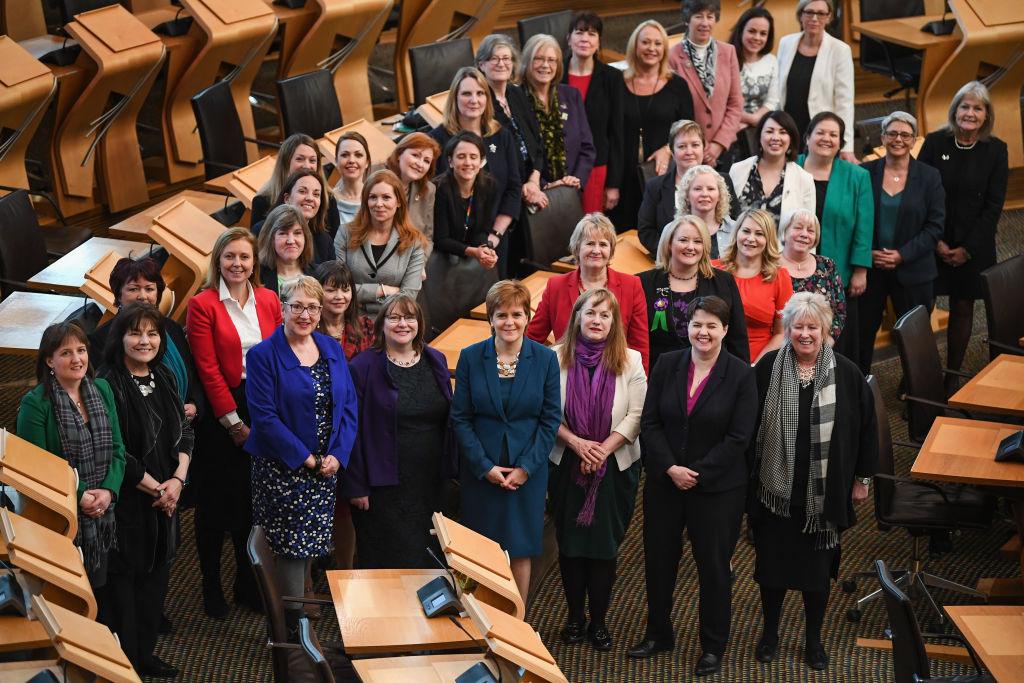Scottish election 2021: Will there be a record number of female MSPs?
- Published

Women MSPs marked the centenary of the Representation of the People Act 1918, which allowed women to vote for the first time.
Scottish voters go to the polls to elect a new crop of MSPs on 6 May, with parties under more pressure than ever to correct the imbalances in the gender and diversity of their representatives.
Could we be on course for the largest contingent of female MSPs ever, and the most diverse parliament in Holyrood's history?

What's the issue?
The three largest parties were all led by women in the last election in 2016, but the result was not a more balanced parliament.
There were 45 female MSPs after that election - the same number as there was before it. That's 35% of the total of 129 MSPs.
Indeed, there were actually more female MSPs in the first parliament in 1999 (48) than there were elected in 2011 or 2016 - suggesting the cause of gender equality at Holyrood might actually have gone backwards.
In the intervening years there has arguably been more pressure on political parties over this issue than ever before, but will this be the year that words will be backed up by deeds?
What are parties doing about it?
Analysis by campaign group Women 50:50, external suggests that 39% of candidates for the upcoming election are female.
The Greens are the closest to gender balance, at 49% female, with the SNP on 47% and Labour on 43%.
The Lib Dems - who did not have a single female MSP in 2016, although they have since gained one in a by-election - are on 40%.
Meanwhile, the Conservatives - a party which does not use quotas but has produced the UK's only two female prime ministers - are sitting on 30%. They say they are "aiming to elect more women than ever before".
This is not just about raw numbers of candidates, though. Since the last election, a range of different measures has been adopted by parties in a bid to improve things.
Some have tried "zipping" their regional lists - alternating male and female candidates - while others have instituted all-women shortlists for constituency contests. But will any of it work?

There were female MSPs at the front of the "class of 2016" photo, but it was still dominated by men in suits
What actually makes a difference?
To test out how the latest efforts at improving diversity could work out, we ran a sort of mock election.
We took the exact results of the 2016 election, and applied it to the 2021 candidate lists, for both regions and constituencies.
What was the result? A record number of female MSPs.
Instead of 45 women at Holyrood, there would be 57. That would see women make up 44% of the parliament - the closest to an actual gender balance since 2003.
Digging a little deeper, what are the policies that would bring this change about?
Of the 12 additional female MSPs in this admittedly imaginary parliament, only four come via the regional lists. Of those four, two would be Green and one a Lib Dem - products of those parties putting women at the top of their lists.
The gender balance of the Tory group would be unchanged, while Labour would gain one female MSP via the lists.
The biggest change is in the constituencies, where the SNP alone would return seven additional female MSPs. This is driven by the party's move to replace retiring male MSPs with women in many (but not all) seats.
In our mock election, this made more difference than every other policy effort put together - which suggests that the most effective way of getting more women into parliament is simply to put them forward for winnable seats.

SCOTLAND'S ELECTION: THE BASICS
What elections are happening? On 6 May, people across Scotland will vote to elect 129 Members of the Scottish Parliament (MSPs). The party that wins the most seats will form the Scottish government. Find out more here.
What powers does the Scottish Parliament have? MSPs pass laws on most aspects of day-to-day life in Scotland, such as health, education and transport. They also have control over some taxes and welfare benefits. Defence, foreign policy and immigration are decided by the UK Parliament.
How do I vote? Anyone who lives in Scotland and is registered to vote is eligible, so long as they are aged 16 or over on the day of the election. You can register to vote online, external.

Could the parliament be more diverse in other ways?
There have only been four MSPs from minority ethnic backgrounds since 1999 - all of them men of Scots-Pakistani heritage. This matches the number of MSPs produced by a single white family, the Ewings.
There have been plenty of warm words from the parties on this topic too, so could it also be in line to change?
Using the same method as above, applying the 2016 results to the 2021 candidate lists, suggests the number of MSPs from minority ethic backgrounds could double in the coming election - albeit from a low base, from two to four.
Holyrood could have its first woman of colour MSP - again via an all-women shortlist for a constituency contest - and the SNP, Labour and Tories would all have minority ethic representation.
Some parties are also making efforts to increase the number of disabled candidates they have, with the SNP saying 20% of its candidates are disabled.
However, this can be much more difficult to quantify than some other metrics, and some parties say they do not want to proactively collect such information.

Why is this important?
There is a simple point that the parliament should reflect the country that it represents - and there are actually estimated to be slightly more women than men in Scotland.
Talat Yaqoob, from Women 50:50, told BBC Scotland's Podlitical podcast that a fairer gender balance could promote different policies at Holyrood.
She said: "I don't think an issue like period poverty would have been taken as seriously or had as much progress if not for feminist women MSPs leading the charge with campaigners on the ground.
"We see that across the board - I think if we had equal numbers of women involved in decision-making, childcare would be seen as an economic priority rather than a side-issue.
"I think our budgeting and our decision-making would be entirely different if there was a fair number of women involved, and I'm hoping that's where we'll get to."
Ms Yaqoob said she was "hopeful" that 2021 would see the election of more women and a more diverse parliament, although she warned that "progress is not linear" and that standards can slip back - as they did after 2003.
While a lack of proper representation can be a vicious cycle - if people don't see themselves reflected in parliament, they may be less likely to go into politics themselves - this can also work the other way and create a more virtuous cycle.
Ms Yaqoob said: "Seeing a more diverse parliament hopefully engages a more diverse population in politics, and maybe tackles some of the apathy we sometimes feel towards politics or that it doesn't work for the average person."

POLICIES: Who should I vote for?
CANDIDATES: Who can I vote for in my area?
PODLITICAL: Updates from the campaign
